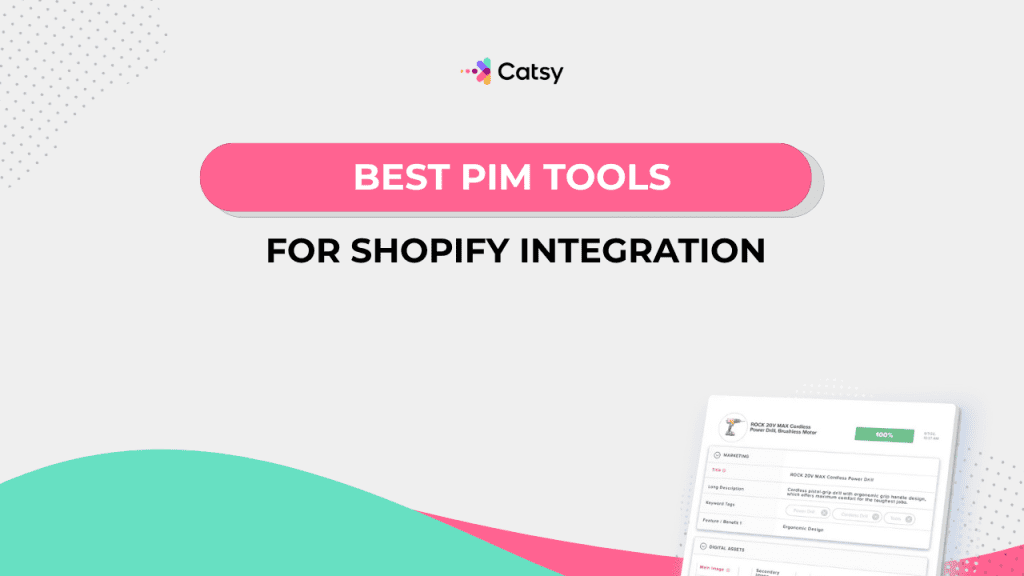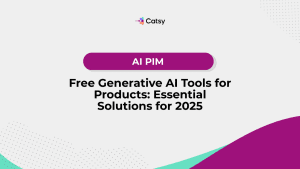PIM Tools vs PIM Systems: What's the Difference?
Choosing the right product information management solution can mean the difference between streamlined operations and data chaos. In the same way that different types of businesses need different levels of tech complexity, your organization needs the right PIM to reach your goals.

Table of Contents
1. Understanding the Fundamentals of PIM
2. PIM Tools – When Simple Solutions Get You There
3. PIM Systems – Enterprise-Grade Platforms for Complex Operations
4. Making the Right Decision for Your Business
What You Will Learn
- How to distinguish between PIM tools and comprehensive PIM systems
- When PIM tools are the right choice for your organization’s needs
- The advantages and capabilities of enterprise-grade PIM systems
- Key factors to evaluate when making your selection decision
- How to plan for future growth while meeting current requirements
- Implementation approaches that minimize risk and maximize value
In this Article
1. Understanding the Fundamentals of PIM
As a business leader, you must understand what product information management can accomplish for you. You must further understand the distinction between tools and systems, and how each will better your business.
Product Information Management serves as a central hub for all of your data. By maintaining a centralized system, you ensure accuracy, consistency, and accessibility… no matter where your customers find you.
Your product data needs to reach multiple destinations safely. Without proper management systems, your information can easily become scattered, inconsistent, or incomplete.
The distinction between PIM tools and PIM systems is similar to the difference between a software application and an enterprise platform. Both will help you manage your data, but each is designed for different business needs and complexities.
a. The Evolution of Business Data Management
Product information management has evolved. We no longer rely on spreadsheets and file cabinets with ledgers! Today’s commerce demands sophisticated systems that are capable of handling complexity across multiple markets – in real time.
A smaller retailer with a dozen products operates with data that’s simple, relative to larger counterparts. Those larger, multinational operations require enterprise-grade capabilities.
Make Catsy DAM and PIM Software an Extension of Your Team
Book a Free Demob. Why the Tool vs System Distinction Matters
The choice between tools and systems isn’t just about features. It’s about matching your PIM’s capabilities with the complexity of your journey.
A weekend sailor crossing a lake doesn’t need the same navigation bridge as a cargo ship crossing the Pacific. In the same way, your business needs PIM capabilities that match your operational complexity without over-engineering.
Understanding this distinction helps you avoid two common navigation errors. The first is being under-equipped for your journey’s demands. The second is being so overwhelmed by equipment that you can’t effectively use what you have.
The key is to find the right balance for your current voyage while keeping an eye on where your business is headed.
Chapter 2: Sailing with PIM Tools - When Simple Navigation Gets You There
PIM tools are the navigation instruments that help smaller businesses navigate. Those smaller businesses don’t need the complexity of a full bridge system.
Focused solutions provide specific capabilities that guide your data management when your needs and goals are clear.
a. The Nature of PIM Tools
Imagine a GPS chart plotter, a depth sounder, and wind instruments. These tools each serve a specific purpose, and together they help provide a safe sailing adventure.
PIM tools operate in a similar way. They’re specialized applications that are designed to handle specific aspects of your business with precision and accuracy.
These tools typically excel in specific areas such as data import and export, basic catalog management, simple workflow automation, channel publishing, and digital asset organization.
In summary, PIM tools focus on doing several jobs well rather than on being everything to everyone.
b. Key Characteristics That Make PIM Tools Effective
PIM tools share characteristics that make them especially suitable for certain businesses. Typically, they will offer a narrower scope of functionality. That means less complexity to master… and a faster ROI!
The cost structure of PIM tools is similar to individually purchased navigation instruments. You’re not trying to outfit an entire bridge; instead you’re seeking tools that do precisely what you need, given your business needs.
Lower upfront costs make these tools more accessible to smaller businesses or those who just wish to test the waters before making a commitment. However, please note that you may find yourself needing additional tools as your requirements change.
Integration capabilities in PIM tools are usually more limited than complete systems. While this simplicity can benefit you, it can also become a limitation as you scale.
c. When PIM Tools Chart the Right Course
PIM tools are most effective for businesses that are navigating relatively clear waters. If you’re managing a small- to mid-sized catalog, these tools often provide exactly what you need to succeed – without additional complexity.
Companies that are testing the PIM waters before making a commitment will enjoy the benefits of PIM tools. Using these tools will provide a greater understanding of the value of a centralized setup, all while limiting risk and investment.
Similarly, businesses with specific product data challenges will often find PIM tools ideal for targeted solutions. A PIM tool can solve problems without requiring a complete overhaul.
Resource constraints, whether financial, technical, or human, also make PIM tools attractive. PIM tools allow organizations with limited resources to still navigate effectively toward their goals.
d. The Advantages of Traveling Light
PIM tools offer several advantages to organizations. First, implementations tend to be faster and less disruptive than they are with systemwide rollout. Your teams can often see benefits within weeks, not months.
Secondly, the learning curve is typically much gentler! Your crew can become proficient in a hurry, without fear of becoming overwhelmed by complex operations.
Finally, flexibility is a key advantage. PIM tools often integrate more easily into your legacy systems. This allows you to enhance your capabilities while maintaining a degree of familiarity.
e. Recognizing When You Need More Than Basic Tools
It’s important to understand that PIM tools have limitations. These may become more apparent as your voyage grows in complexity. Compare it to sea travel – you may find that you need a bigger boat for a more demanding journey.
Integration challenges emerge as you require different tools to integrate. You may find it necessary to manually transfer data between systems, and this may cause errors. Scaling limitations may also become more apparent as your catalog grows, or as you expand into new markets.
Chapter 3: Commanding with PIM Systems - Enterprise-Grade Navigation for Complex Voyages
A PIM system is the equivalent of a modern ship’s integrated bridge system. Comprehensive platforms provide coordinated, enterprise-grade capabilities for complex business matters.
These solutions are designed to help organizations with complicated product information management needs.
a. The Architecture of Comprehensive Platforms
Radar, GPS, electronic charts, communications, engine monitoring, and weather systems all work in concert on a ship. With a PIM, you’ll find that each aspect of your product information management will work together in the same way.
PIM systems typically include advanced data modeling capabilities which allow you to structure product information in sophisticated ways. The result is a complete picture that enables better decision-making and more efficiency.
Workflow management in PIM systems resembles the coordinated operations of a large vessel. Different departments must work together seamlessly, just as the bridge coordinates with engineering, cargo management, and communications.
PIM systems facilitate complex approval processes, data validation, and publishing workflows across each of your teams.
b. Enterprise-Grade Capabilities for Complex Operations
Your PIM’s integration capabilities should be like those of a ship’s navigation. All of the parts must work together as a whole, communicating without effort.
PIM platforms typically offer APIs and built-in connectors that will allow them to coordinate with ERP systems, automation tools, and more.
If you’re operating in global waters, you’ll need multi-language and regional support. Global businesses need PIM capabilities that can handle languages, currencies, regulations, and more … without error.
Advanced rights management and user controls are also important. They can be likened to sophisticated aces controls throughout a ship. Different crew members need different access to different tools in order to keep the ship running smoothly. A PIM system can provide granular control over who can edit, access, or approve your material.
c. The Power of Comprehensive Analytics
Your PIM system will probably provide you with comprehensive analytics and reporting. You can track data quality, monitor workflow efficiency, and identify opportunities to optimize, no matter where you sell.
These analytics help you navigate not just your current voyage, but also plan better routes for future journeys. Understanding how your product information flows through your organization and which processes deliver the best results enables continuous improvement for your teams.
d. When Comprehensive Systems Become Essential
A large organization with a complex product line is like a shipping fleet with multiple vessels and routes. Businesses with diverse product lines, multiple brands, or complex tech specs need a PIM system that can handle the variety.
If you’re operating across multiple regions or languages, you face unique challenges. PIM systems provide the standardized – yet flexible – framework you need to manage these complexities. Consistency and compliance are not compromised.
Do you require extensive third-party integrations? PIM systems can help provide the integration capabilities you need.
e. The Investment in Professional-Grade Solutions
PIM systems typically require a larger upfront investment. However, that investment typically leads to long-term ROI within organizations that need the complexity of a comprehensive system.
Implementation complexity of a PIM system is higher, much like training your crew to use navigation systems. Your team may be resistant and may need more time to become proficient. In the end, though, your result is a system that can handle just about any scenario your business may encounter!
The customization and flexibility of PIM systems allows them to adapt to your unique business requirements. This flexibility ensures that your investment continues to provide value as your business evolves.
Chapter 4: Choosing Your Course - Making the Right Decision for Your Journey
Choosing between PIM tools and systems is ultimately about understanding your own business needs and goals. As you would when choosing a sailing vessel, you’ll need to conduct an honest assessment of your capabilities, requirements, and aspirations.
a. Assessing Your Current Position
Before you choose your system or your tools, you need to figure out where your business stands today. Assess your catalog! How many SKUs do you manage? How many channels are you selling on? How many global regions do you operate in?
What about your team? Do you have team members with technical expertise to implement and maintain complex systems? What’s your appetite for change management? For training? How quickly do you need to see results?
Financial considerations are like determining your vessel’s budget for navigation equipment. It’s tempting to choose the least expensive option, but you’ll want to consider the total cost of ownership. Include implementation, training, and ongoing maintenance.
b. Understanding Future Requirements
Chart your growth as you would chart your ship’s voyage. If you’re anticipating a growth spurt, you’ll need “navigation equipment” that will grow with you. A solution that is working perfectly for you now may not work as well as you scale.
Regulatory and compliance requirements are an example of this. Some industries will need extensive documentation, audit trails, and governance capabilities – tools may not be able to handle this.
You’ll also need to consider integration requirements with your legacy systems. Look for seamless integration with your ERP, CRM, or e-commerce platforms; this may drive your decision as you choose a system.
c. The Phased Implementation Approach
Many organizations experience success when rolling our implementation in a “chunky” way. Phased approaches can keep your teams from becoming overwhelmed, all while maintaining your data quality and accuracy.
This approach also lets you demonstrate ROI with smaller investments. This makes it easier to justify a more comprehensive solution later. It also allows you to migrate data and processes gradually, minimizing disruption to ongoing operations while building confidence in your team’s ability to manage more sophisticated systems.
Choose initial tools that can integrate well with future systems, like selecting navigation instruments that can eventually become part of a more comprehensive bridge setup.
d. Recognizing When to Upgrade
There are several indicators that may suggest that it’s time to look for a more robust solution. If you’re finding disconnected tools to manage your data, that’s a sign!
Data quality issues that persist despite your efforts to correct them may indicate that your current strategy isn’t a good fit for you. Your legacy systems may lack governance and workflow capabilities.
Scalability constraints that limit your business growth are also clear signals that your current navigation equipment isn’t adequate. If your PIM tools can’t keep up with your business expansion, they’re keeping you from success.
e. Making the Final Decision
The choice between PIM tools and systems ultimately comes down to matching your navigation capabilities to your journey’s demands. Consider where you are today, but think about where you’d like to be tomorrow.
If you have a straightforward catalog, a limited geographic scope, and a stable business model, PIM tools may be quite adequate. Businesses like these can achieve their goals without unnecessary complexity.
For those of you with more complex portfolios, global operations, or rapid growth trajectories, a PIM system may be a better fit. A complete system will allow you to coordinate variables across literal waters. An integrated system can handle complexity with precision and reliability.
f. Future-Proofing Your Investment
Regardless of which path you choose, consider how your decision will serve you as conditions change. Technology capabilities, market requirements, and business complexity all evolve, and you’ll need to chart your course accordingly.
Vendor stability and product roadmaps are essential! Choose providers with strong track records and clear development directions that align with your business goals.
Community and ecosystem support can be invaluable resources, too. Solutions with active user communities and extensive partner ecosystems often provide better long-term value.
g. The Art of Successful Implementation
Remember that the most sophisticated navigation equipment is only as effective as the crew operating it. Invest in training and change management to ensure that your team can utilize whatever solution you choose.Have patience! PIM expertise takes time and practice.
Success in product information management requires the right tools, but also clear processes. Well-trained teams and a commitment to continuous improvement are essential, too. Whether you choose tools or systems, focus on building the organizational capabilities needed to maximize your investment.
The goal isn’t to have the most advanced navigation equipment; it’s to reach your destination safely, efficiently, and profitably. Choose the PIM approach that best serves your business objectives while providing room to scale.
Key Takeaways
Navigate with Purpose: Choose PIM solutions based on your actual journey requirements, not the most advanced features available. Simple tools work perfectly for straightforward voyages, while complex operations demand comprehensive systems.
Plan for Growth: Consider your current position against your destination… and the waters you’ll navigate along the way. Your PIM choice should support your business evolution without requiring a complete overhaul.
Invest in Your Crew: The best navigation equipment is only as effective as the team operating it. Prioritize training to ensure that your organization can fully utilize your chosen solution.
Start Your Voyage: The perfect PIM solution is the one you actually implement and use effectively. Don’t let the pursuit of perfection hold you back! Start small, then build as you grow.
Maintain Course Flexibility: Whether you choose tools or systems, ensure your solution can adapt as business conditions change. The ability to adjust your navigation approach is often more valuable than having every possible feature from day one.
Want more tips, tutorials, and insights on product content and e-commerce operations?
Stay connected. We post regularly to help brands like yours scale smarter.
Are You Ready To streamline your product content management?

Frequently Asked Questions
Yes! Many organizations successfully follow this progression with great success. Choose tools that export data easily and consider how they’ll integrate with future systems.
Key indicators include excessive time spent on manual processes, data quality issues, issues with scaling, and others! These signs can suggest that it’s time to implement a new navigational system.
PIM tools often deliver value within 2 to 8 weeks, while PIM systems typically require 3-12 months for full implementation. The exact timeline depends on your data complexity, integration requirements, and organizational readiness.
PIM tools usually require minimal technical expertise. Conversely, PIM systems often benefit from dedicated technical resources or partnership with experienced implementation providers. Seek a platform that offers support now and in the future.
Consider time savings from automated processes, reduced errors from better data quality, increased sales from improved product information, and cost avoidance from not implementing multiple point solutions. PIM ROI often comes from operational improvements rather than just feature capabilities.
While switching solutions involves some effort, it’s not catastrophic if you plan ahead! Choose solutions with good data export capabilities, and avoid vendor lock-in if you can. Many businesses successfully migrate from simple tools to complete systems as their needs evolve. You can, too!
This decision is like choosing between satellite navigation services and maintaining your own navigation infrastructure. Cloud solutions offer lower maintenance overhead and faster deployment, but on-premise systems provide more control and customization. Most modern organizations prefer cloud-based solutions unless specific regulatory or security requirements mandate on-premise deployment.
Subscribe For More Content
Sign up for monthly tips on how to drive revenue with product content.




